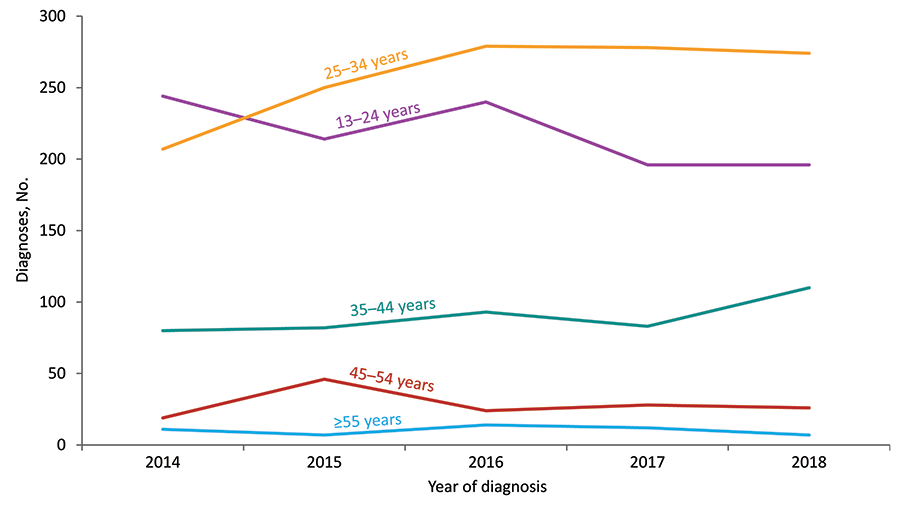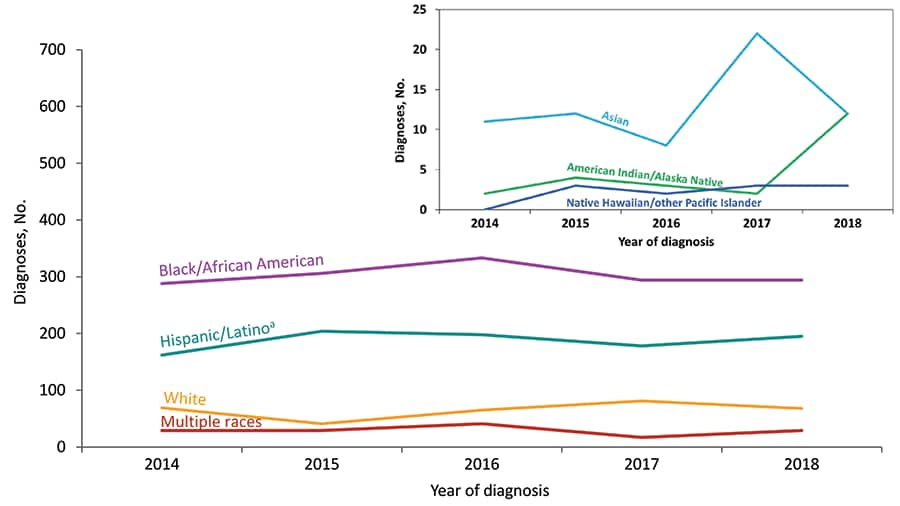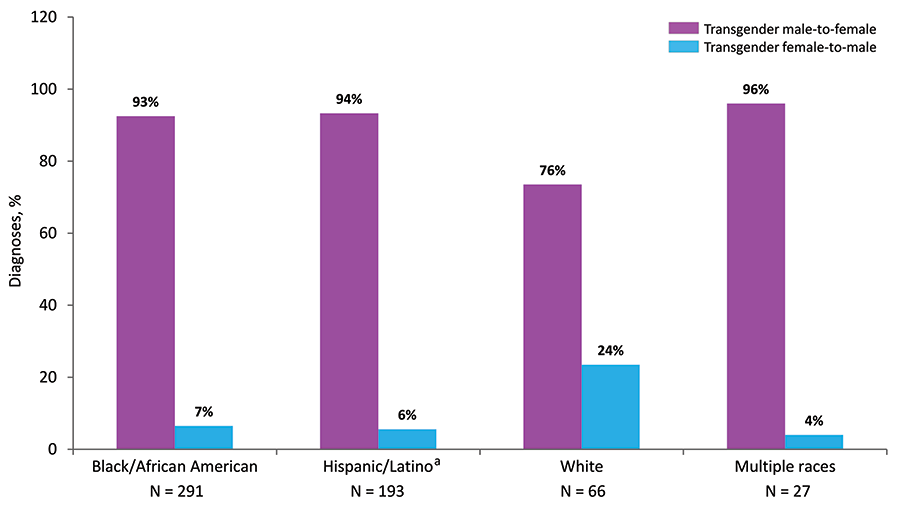Diagnoses of HIV Infection in the United States and Dependent Areas, 2018: Transgender Persons

The Special Focus Profiles highlight trends and distribution of HIV in 5 populations of particular interest to HIV prevention programs in state and local health departments: (1) Transgender Persons, (2) Gay, Bisexual, and Other Men Who Have Sex With Men, (3) Persons Who Inject Drugs, (4) Women, and (5) Children Aged <13 Years.
Transgender is an umbrella term that is used to identify persons whose sex assigned at birth does not match current gender identity or expression. Gender identity refers to one’s internal understanding of one’s own gender, or the gender with which a person identifies. Gender expression is a term used to describe people’s outward presentation of their gender. Gender identity and sexual orientation are different facets of identity. Everyone has a gender identity and a sexual orientation, but a person’s gender does not determine a person’s sexual orientation. Transgender persons may identify as heterosexual, homosexual, bisexual, or none of the above. Transgender persons face numerous prevention challenges, including lack of public/provider knowledge about transgender issues and social rejection and exclusion, and are understudied in HIV prevention (e.g., pre-exposure prophylaxis, [PrEP]) and treatment interventions.
Diagnoses of HIV Infection
Gender
From 2014 through 2018 in the United States and 6 dependent areas, the number of diagnoses of HIV infection for transgender adults and adolescents increased (Table 4b). In 2018, among all adults and adolescents, diagnoses of HIV infection among transgender persons accounted for approximately 2% of diagnoses of HIV infections in the United States and 6 dependent areas. In 2018, among transgender adults and adolescents, the largest percentage (92%) of diagnoses of HIV infections was for transgender MTF.
Figure 11. Diagnoses of HIV Infection among Transgender Adults and Adolescents, by Age at Diagnosis, 2014–2018—United States and 6 Dependent Areas

Note: See Data Tables, Definitions, and Acronyms for more information on gender.
From 2014 through 2018 in the United States and 6 dependent areas, the number of diagnoses of HIV infection for transgender adults and adolescents aged 25–34, 35–44, and 45–54 years increased (Figure 11). The number for transgender adults and adolescents aged 13–24 years decreased. In 2018, the largest percentage (27%) of diagnoses of HIV infection was for transgender MTF adults and adolescents aged 25–29 years, followed by the percentage (25%) for transgender MTF adults and adolescents aged 20–24 years (Table 4b). Please use caution when interpreting data for transgender adults and adolescents 13–14 and 50 years and older as well as for transgender FTM adults and adolescents 15–24 and 30–49 years and older: the numbers are small.
Figure 12. Diagnoses of HIV Infection among Transgender Adults and Adolescents, by Race/Ethnicity, 2014–2018—United States and 6 Dependent Areas

Note: See Data Tables, Definitions, and Acronyms for more information on race/ethnicity.
a Hispanics/Latinos can be of any race.
From 2014 through 2018 in the United States and 6 dependent areas, the number of diagnoses of HIV infection for Hispanic/Latino transgender adults and adolescents increased (Figure 12 and Table 4b). The number of diagnoses of HIV infection for black/African American and white transgender adults and adolescents and for transgender adults and adolescents of multiple races remained stable.
Figure 13. Percentages of Diagnoses of HIV Infection among Transgender Adults and Adolescents, by Gender and Race/Ethnicity, 2018—United States and 6 Dependent Areas

Note: See Data Tables, Definitions, and Acronyms for more information on gender and race/ethnicity.
a Hispanics/Latinos can be of any race.
In 2018 in the United States and 6 dependent areas, among transgender adults and adolescents, the percentage of diagnoses of HIV infection among transgender MTF, vs. transgender FTM, was largest among persons of multiple races (96%), followed by Hispanics/Latinos (94%) and blacks/African Americans (93%) (Figure 13 and Table 4b). Please use caution when interpreting data for American Indian/Alaska Native, Asian, and Native Hawaiian/other Pacific Islander transgender adults and adolescents: the numbers are small.
Region
From 2014 through 2018 in the United States, the number of diagnoses of HIV infection among transgender adults and adolescents in the Northeast and West increased (Table 4b). The numbers for transgender adults and adolescents in the Midwest and South remained stable. In 2018 in the United States, among all transgender adults and adolescents, the largest percentage (41%) of diagnoses of HIV infection was for transgender adults and adolescents in the South, followed by 24% in the West, 19% in the Northeast, and 16% in the Midwest. Among transgender adults and adolescents, the larger percentage of diagnoses of HIV infection in each of the 4 regions was for transgender MTF.
| 2014 | 2015 | 2016 | 2017 | 2018 | |
|---|---|---|---|---|---|
| No. | No. | No. | No. | No. | |
| Transgender male-to-female adult or adolescenta | |||||
| Age at diagnosis (yr) | |||||
| 13–14 | 1 | 0 | 0 | 0 | 0 |
| 15–19 | 62 | 62 | 52 | 47 | 30 |
| 20–24 | 171 | 143 | 179 | 135 | 148 |
| 25–29 | 129 | 158 | 174 | 156 | 163 |
| 30–34 | 67 | 72 | 90 | 100 | 81 |
| 35–39 | 38 | 52 | 65 | 50 | 69 |
| 40–44 | 33 | 22 | 23 | 28 | 32 |
| 45–49 | 10 | 25 | 15 | 17 | 18 |
| 50–54 | 5 | 18 | 7 | 7 | 6 |
| 55–59 | 5 | 5 | 8 | 6 | 4 |
| 60–64 | 3 | 2 | 2 | 5 | 2 |
| ≥65 | 2 | 0 | 3 | 0 | 1 |
| Race/ethnicity | |||||
| American Indian/Alaska Native | 2 | 3 | 3 | 2 | 11 |
| Asian | 11 | 12 | 7 | 18 | 10 |
| Black/African American | 272 | 288 | 322 | 278 | 272 |
| Hispanic/Latinob | 153 | 195 | 189 | 168 | 182 |
| Native Hawaiian/other Pacific Islander | 0 | 3 | 2 | 3 | 3 |
| White | 60 | 32 | 58 | 68 | 50 |
| Multiple races | 28 | 26 | 37 | 14 | 26 |
| Region of residencec | |||||
| Northeast | 101 | 127 | 137 | 94 | 106 |
| Midwest | 84 | 87 | 85 | 85 | 87 |
| South | 233 | 237 | 269 | 244 | 232 |
| West | 104 | 104 | 125 | 126 | 128 |
| U.S. dependent areas | 4 | 4 | 2 | 2 | 1 |
| Subtotal | 526 | 559 | 618 | 551 | 554 |
| Transgender female-to-male adult or adolescenta | |||||
| Age at diagnosis (yr) | |||||
| 13–14 | 0 | 0 | 0 | 0 | 0 |
| 15–19 | 1 | 2 | 1 | 3 | 2 |
| 20–24 | 6 | 4 | 4 | 8 | 10 |
| 25–29 | 5 | 7 | 5 | 15 | 18 |
| 30–34 | 3 | 7 | 3 | 2 | 7 |
| 35–39 | 3 | 2 | 4 | 2 | 4 |
| 40–44 | 4 | 5 | 1 | 0 | 4 |
| 45–49 | 4 | 2 | 2 | 2 | 1 |
| 50–54 | 0 | 1 | 0 | 0 | 1 |
| 55–59 | 1 | 0 | 0 | 1 | 0 |
| 60–64 | 0 | 0 | 0 | 0 | 0 |
| ≥65 | 0 | 0 | 0 | 0 | 0 |
| Race/ethnicity | |||||
| American Indian/Alaska Native | 0 | 1 | 0 | 0 | 0 |
| Asian | 0 | 0 | 1 | 3 | 0 |
| Black/African American | 13 | 14 | 5 | 10 | 19 |
| Hispanic/Latinob | 6 | 6 | 6 | 6 | 11 |
| Native Hawaiian/other Pacific Islander | 0 | 0 | 0 | 0 | 0 |
| White | 8 | 7 | 5 | 11 | 16 |
| Multiple races | 0 | 2 | 3 | 3 | 1 |
| Region of residencec | |||||
| Northeast | 6 | 4 | 1 | 5 | 8 |
| Midwest | 9 | 9 | 5 | 9 | 7 |
| South | 5 | 12 | 6 | 11 | 15 |
| West | 7 | 5 | 8 | 8 | 17 |
| US dependent areas | 0 | 0 | 0 | 0 | 0 |
| Subtotal | 27 | 30 | 20 | 33 | 47 |
| Total | 553 | 589 | 638 | 584 | 601 |
Note: Additional gender identity not included due to small numbers. Numbers less than 12 should be interpreted with caution.
a“Transgender male-to-female” includes individuals who were assigned “male” sex at birth but have ever identified as “female” gender. “Transgender female-to-male” includes individuals who were assigned “female” sex at birth but have ever identified as “male” gender.
bHispanics/Latinos can be of any race.
cData are based on residence at time of diagnosis of HIV infection.
Gender identity refers to a person’s internal understanding of their own gender, or gender with which a person identifies. HIV surveillance personnel collect data on gender identity, when available, from sources such as case report forms submitted by health care or HIV testing providers and medical records, or by matching with other health department databases (e.g., Ryan White program data). In May 2013, CDC issued guidance to state and local programs on methods for collecting data on transgender persons and working with transgender-specific data. However, characterization of HIV infection among transgender persons may require supplemental data from special studies. A person’s transgender status in NHSS is determined based on two variables – sex assigned at birth and current gender identity. Both variables are examined, using a two-step approach, to assess transgender status. Although not used in this report, cisgender is a term used to indicate that a person’s sex assigned at birth and current gender identity are the same (i.e., a person assigned male at birth and who currently identifies as a man, is a cisgender male).
Categories
- Male: persons assigned “male” sex at birth and current gender identity is not “transgender male-to-female” or “additional gender identity” (current gender identity can be listed as “male,” “female,” “transgender female-to-male,” “unspecified,” or left blank).
- Female: persons assigned “female” sex at birth and current gender identity is not “transgender female-to-male” or “additional gender identity” (current gender identity can be listed as “male,” “female,” “transgender male-to-female,” “unspecified,” or left blank).
- Transgender male-to-female (transgender MTF): persons assigned “male” sex at birth and current gender identity is “transgender male-to-female.”
- Transgender female-to-male (transgender FTM): persons assigned “female” sex at birth and current gender identity is “transgender female-to-male.”
- Additional gender identity (AGI): persons assigned “male” or “female” sex at birth and current gender identity is “additional gender identity.” AGI includes “bigender,” “gender queer,” and “two-spirit.”
In the Federal Register [6] for October 30, 1997, the Office of Management and Budget (OMB) announced the Revisions to the Standards for the Classification of Federal Data on Race and Ethnicity. Implementation by January 1, 2003 was mandated. At a minimum, data on the following race categories should be collected:
- American Indian or Alaska Native
- Asian
- black or African American
- Native Hawaiian or other Pacific Islander
- white
Additionally, systems must be able to retain information when multiple race categories are reported. In addition to data on race, data on 2 categories of ethnicity should be collected:
- Hispanic or Latino
- not Hispanic or Latino
The Asian or Pacific Islander category displayed in annual surveillance reports published prior to the 2007 surveillance report was split into 2 categories: (1) Asian and (2) Native Hawaiian or other Pacific Islander. The Asian category (in tables where footnoted) includes the cases in Asians/Pacific Islanders (referred to as legacy cases) that were reported before the implementation of the new race categories in 2003 (e.g., cases of HIV infection that were diagnosed and reported to CDC before 2003 but that were classified as stage 3 [AIDS] after 2003) and a small percentage of cases that were reported after 2003 but that were reported according to the old race category (Asian/ Pacific Islander). In tables of diagnoses of HIV infection during 2014–2018, the Asian category does not include Asian/Pacific Islander cases because these cases were diagnosed after 2003 and were reported to CDC in accordance with OMB’s Revisions to the Standards for the Classification of Federal Data on Race and Ethnicity [6].
This report also presents data for persons for whom multiple race categories are reported. In this report, persons categorized by race were not Hispanic or Latino. The number of persons reported in each race category may, however, include persons whose ethnicity was not reported.
AGI: additional gender identity
AIDS: acquired immunodeficiency syndrome
CDC: Centers for Disease Control and Prevention
FTM: female-to-male
HIV: human immunodeficiency virus
IDU: injection drug use
MSA: metropolitan statistical area
MSM: gay, bisexual, and other men who have sex with men
MTF: male-to-female
NHSS: National HIV Surveillance System
NIR: no identified risk factor
OI: opportunistic illness
OMB: Office of Management and Budget
PrEP: preexposure prophylaxis
PWID: persons who inject drugs